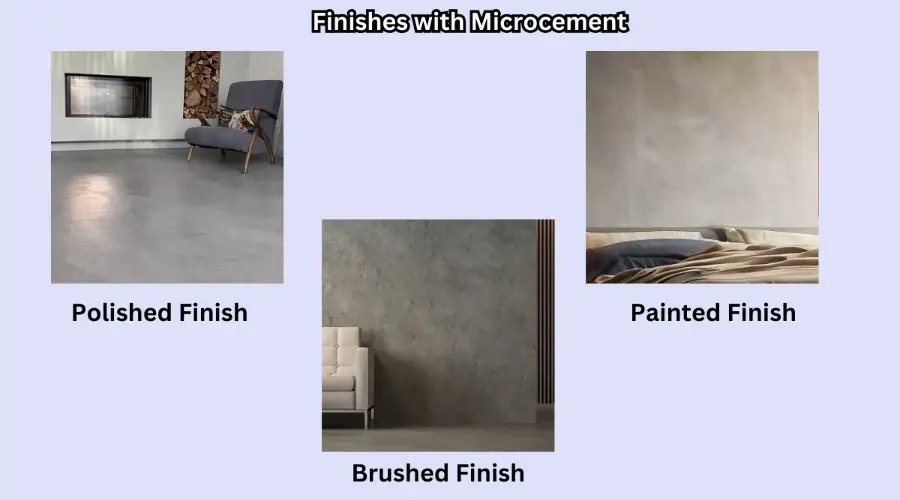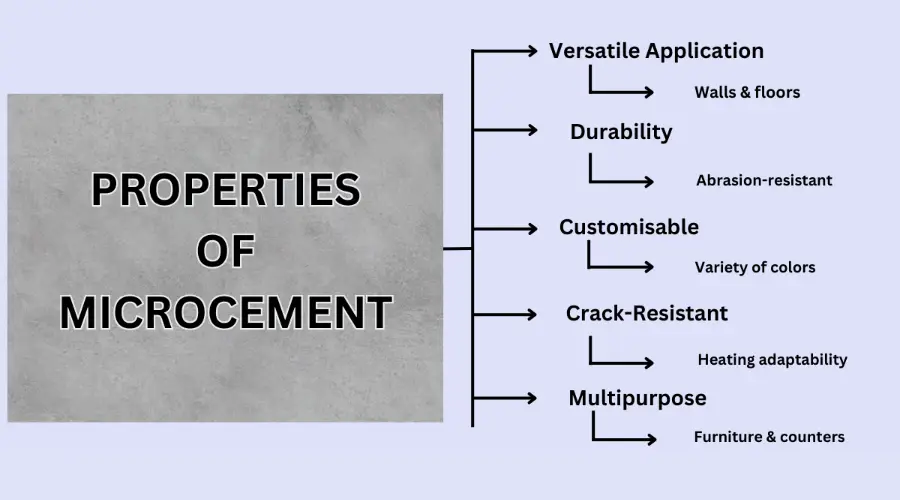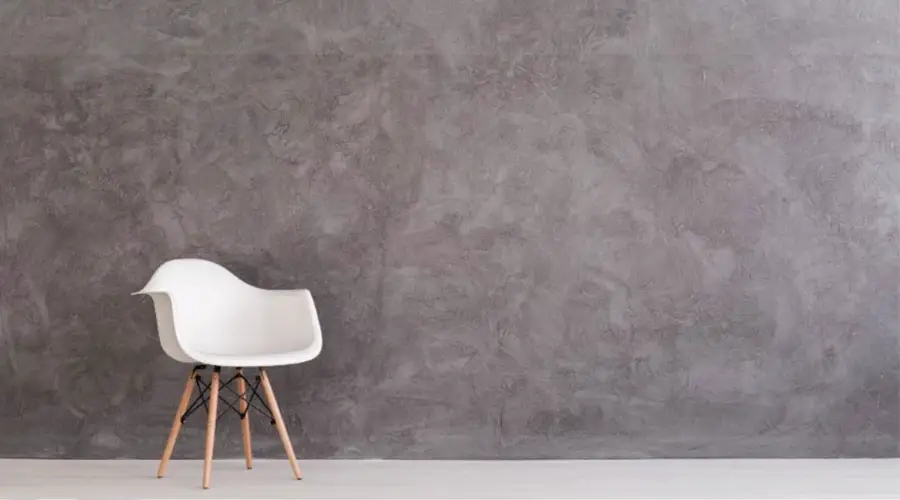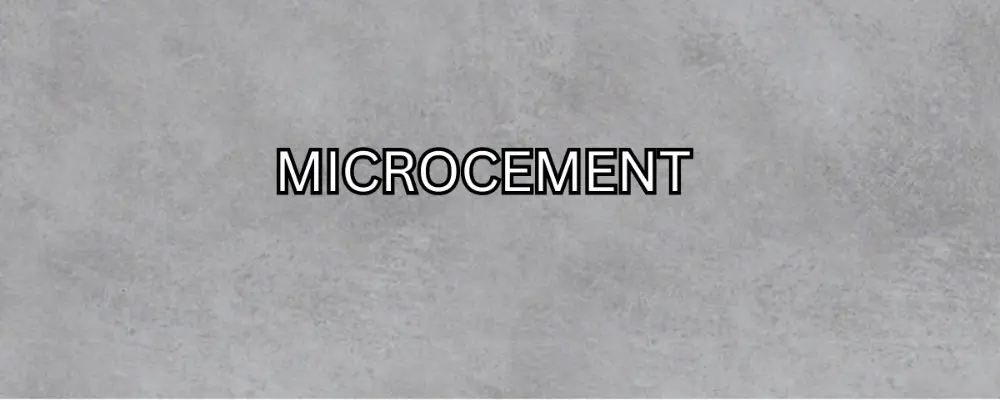Aesthetic appeal is considered a crucial aspect of every building work, especially in commercial or individual villas. Attractive features can be added to grasp the attention of people who look into the structure.
Microcement is also used as a decorative coating that consists of ingredients such as cement, water-based resins, additives, and mineral pigments. For remodelling purposes, this cement is widely used. It can also stick well to a variety of surfaces, including marble, terrazzo, plasterboard, tiles, and more. It effectively transforms spaces with only a 3 mm thickness.
What is Microcement?
A cement-based substance that is applied to surfaces to create a sleek, contemporary appearance is known as microcement. It is an excellent option for decorative walls and floors because it is economical and environmentally friendly, having been made from natural materials like sand and lime.
Microcement is mixed on-site and manually applied in 2-3 mm layers using trowels. It is also referred to as microcrete, microconcrete, micro-overlay, micro-topping, or cement coating. A seamless, joint-free surface is the end product.
Production of Microcement
Microcement is made by combining cement powder, fine sand (such as quartz powder), and water-based resins. This creates a thin, cement-based coating that gives almost any surface a polished concrete look with a sleek, industrial-chic finish. Its thin application makes it lighter and more affordable compared to traditional concrete.
The process involves:
- Preparation: Cement and fine sand are mixed thoroughly to create an even base.
- Adding Polymers: Liquid polymers (water-based resins) are included to make the mixture more flexible and durable, setting microcement apart from regular cement.
- Achieving Consistency: The mixture is stirred into a smooth paste, ensuring the colour and texture are evenly distributed.
Finishes with Microcement

A Polished Finish: It gives a surface a smooth, stone-like appearance that is ideal for contemporary residences and business buildings.
Brushed Finish: The rough, rustic appearance of a brushed finish makes it perfect for vintage or industrial décor.
Painted Finish: Gives kitchens or bathrooms a new look by adding colour and depth. Unlike polished finishes, which only require one coat of paint and sealing, this calls for two coats.
Every finish has advantages and disadvantages, so pick the one that best suits your style. Keep in mind that painted finishes can change the colour a little. Before beginning the project, use augmented reality technologies to see how microcement will seem in your area for better planning.
Properties of Microcement

With a variety of textures (thick, medium, or fine), colours, and finishes that may be customised with varnishes and metallic coatings, microcement provides countless design options that enable the creation of distinctive and fashionable rooms. Their unique properties are discussed below:
- Versatile Application: Suitable for walls and floors that are both new and old.
- Durability: Extremely abrasion-resistant and quick to harden.
- Customisable: They come in a variety of colours to suit your style preferences.
- Crack-Resistant: They are adaptable and perfect for use with heating beneath floors.
- Multipurpose: Trowels are used to apply thin layers that are appropriate for furniture, walls, floors, and counters.
Application of Microcement
Flooring Made of Microcement
- They provide long-lasting and easily cleaned floors.
- Ideal for residential, commercial, and industrial locations with lots of traffic.
- Provides a variety of customisable finishes, including rustic, textured, and polished.
- An economical substitute for conventional flooring materials.
Bathrooms with Microcement
- Seamless, waterproof, and grout-free surfaces can be made by using micro cement in bathrooms that reduce dirt and mold buildup while being durable, easy to clean, and available in customisable finishes.
Worktops with Microcement
- Create stylish, long-lasting, and seamless kitchen surfaces that are stain-resistant and require minimal maintenance.
- Adaptable to contemporary kitchen styles, offering both functionality and modern design.
Microcement for Outdoors
- Microcements are ideal for creating durable, weatherproof walkways, patios, and terraces, offering a smooth, modern look for outdoor spaces.
Walls using Microcement

- They are easily adaptable to rustic, rough, sleek, or smooth finishes.
- Ideal for feature walls, it may be applied to curved or uneven surfaces.
- Microcements are incredibly resilient and long-lasting.
Kitchens with Microcement
- Ideal for kitchen spaces with lots of traffic and used for flooring, backsplashes, and countertops.
- They produce a sleek, contemporary appearance with excellent stain resistance.
Microcement Steps
- Can create sturdy, non-slip risers and treads, which are also applicable to metal, wood, or concrete staircases.
- Adaptable to any type of design space.
Showers of Microcement
- Water-resistant, seamless surfaces that are perfect for bathrooms.
- A variety of styles and finishes that are simple to maintain and clean.
- They guarantee durability and guard against water damage.
Furniture Made with Microcement
- Modern furniture is made with plastic, metal, or wood surfaces that are incredibly durable, stain- and scratch-resistant. It is an ideal choice for places that have heavy foot traffic areas.
Pools of Microcement
- Waterproof, seamless pool surfaces with low-maintenance design, customisable finishes, and an affordable, stylish option for outdoor living areas.
How to Apply Microcement?
Multiple thin layers of microcement are placed to produce a finish that is robust, long-lasting, and aesthetically pleasing. The procedure entails
Base Coats:
Cement containing bigger sand particles is put in the first two coatings. These serve as the cornerstone of the application of microcement, offering strength and longevity.
Finish Coats:
To get the appropriate texture and colour, two finer layers are then applied using cement and fine fillers.
A Multi-Level Strategy for Strength
The structure of plywood, which consists of multiple thin layers adhered together, can be likened to the application procedure. Together, these layers produce a substance that is more robust and long-lasting than a single, thick piece of wood.
Similarly, several microcement layers are joined, each of which adds to the finished product’s strength and stability. Sanding each microcement layer produces a surface that guarantees a strong bond for the subsequent layer. This methodical procedure yields a smooth, seamless finish.
Superior Design for Sturdiness
The base layers of products such as MicroWall and MicroFloor overlays are made of carefully selected pebbles that interlock, much like a dry stone wall. Both compressive strength (resistance to large loads) and tensile strength (resistance to cracking or breaking) are improved by this interlocking arrangement.
Improved Qualities of Liquid Polymers
In contrast to conventional cement, microcement substitutes a liquid polymer for water. The qualities of this invention are as follows:
- Enhanced surface adherence.
- Increased water resistance.
- Increased material flexibility and lowered the chance of cracking.
- The end product is a durable, adaptable substance that blends strength, pliability, and beauty.
Places to Apply Microcement
Microcement is a material that can be used in many different ways. Here’s a thorough breakdown of each:
Floors and Walls
The most popular applications for microcement are in wall coverings and flooring. Its smooth texture gives it a contemporary, tidy, and easily maintained look, making it perfect for kitchens, bathrooms, and terraces.
Stairs
Stairs can have a smooth, minimalist appearance with no visible joints by using microcement. It is therefore a well-liked option for both business and residential settings.
Pools for swimming
Microcement is ideal for pool cladding due to its lasting and waterproof qualities. It produces a consistent surface that is useful and aesthetically pleasing in damp conditions.
Cladding for Furniture
A stylish, durable, and unique appearance can be made for furniture using microcement. This is ideal for customising tables, countertops, and other pieces of furniture.
Areas with High Traffic
Microcement’s exceptional resistance to damage from regular use makes it suitable for areas with frequent usage like bathrooms and kitchens. It can withstand frequent cleanings and heavy foot traffic due to its durability.
Clean Environments
Microcement is applied without joints, removing spaces where bacteria and dirt can grow. Because of this, it’s a great option for places that value hygiene, such as hospitals, dining establishments, or residences with high cleaning requirements.
Conclusion
The benefits of microcement extend beyond the original outlay, providing long-term advantages in terms of upkeep, beauty, and adaptability. Microcement offers a solution that blends creativity and functionality, guaranteeing your project will be both aesthetically pleasing and long-lasting, whether you’re remodelling or starting from scratch.

